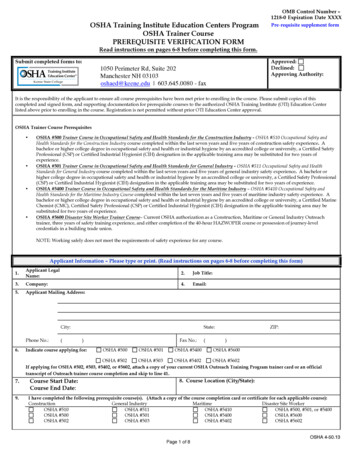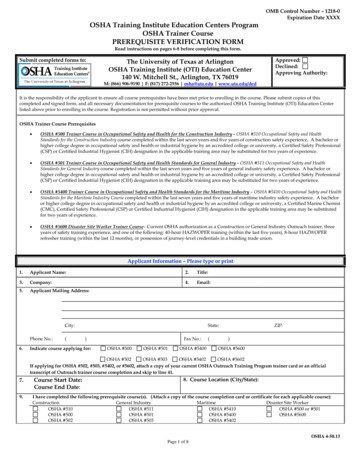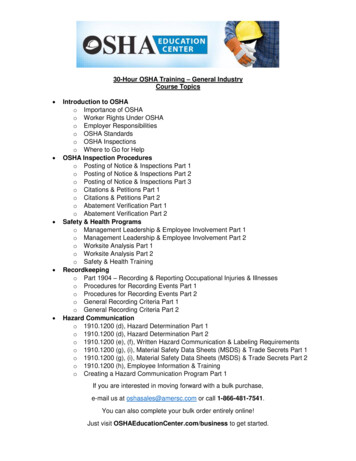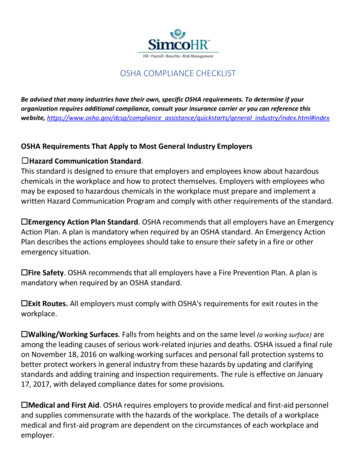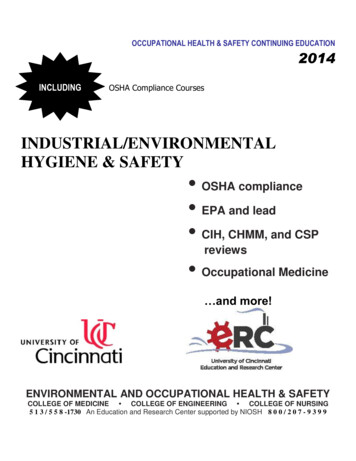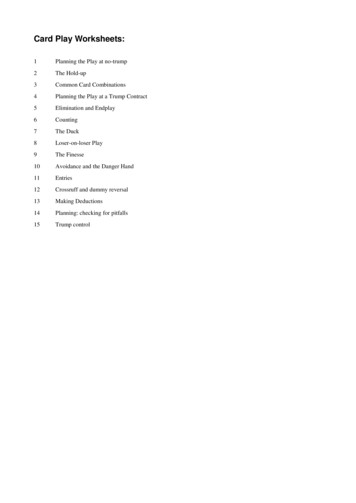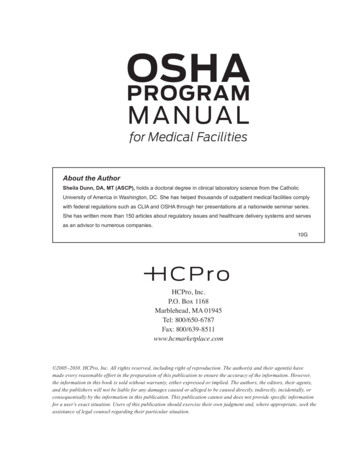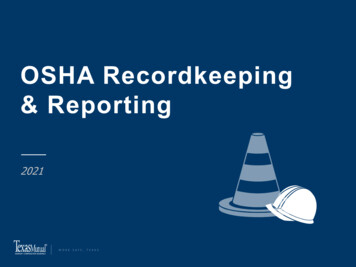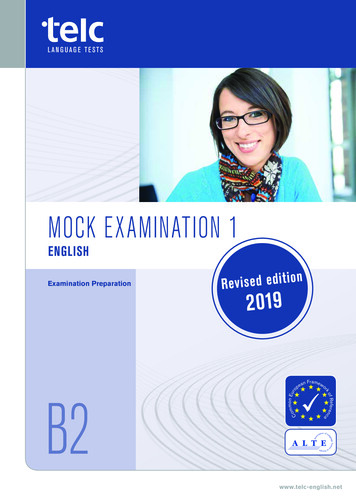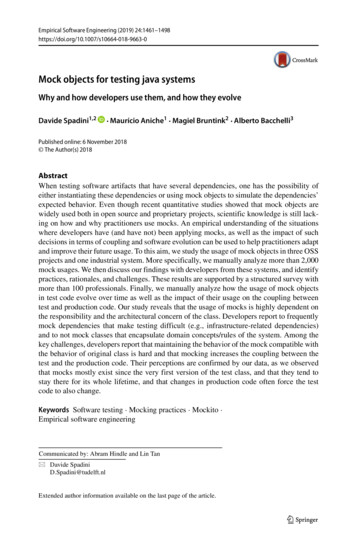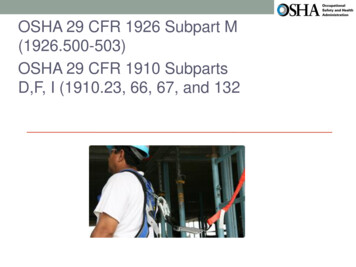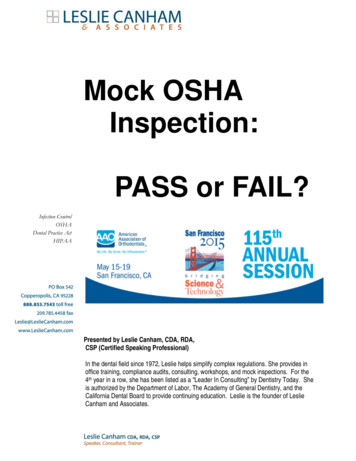
Transcription
Mock OSHAInspection:PASS or FAIL?Infection ControlOSHADental Practice ActHIPAAPresented by Leslie Canham, CDA, RDA,CSP (Certified Speaking Professional)In the dental field since 1972, Leslie helps simplify complex regulations. She provides inoffice training, compliance audits, consulting, workshops, and mock inspections. For the4th year in a row, she has been listed as a “Leader In Consulting” by Dentistry Today. Sheis authorized by the Department of Labor, The Academy of General Dentistry, and theCalifornia Dental Board to provide continuing education. Leslie is the founder of LeslieCanham and Associates.
Quick Guide to OSHA OSHA Training conducted annually and documented-Keep 3 years Hepatitis B vaccine offered to clinical employees within 10 ten days Documentation of immunity to Hepatitis B on file If employee declines Hepatitis B vaccine, signature on file OSHA manual up to date www.osha.gov/Publications/osha3186.pdf for Model Plans OSHA Poster present www.osha.gov/Publications/osha3165.pdf Copy of the Bloodborne Pathogen Standard available Employee record keeping and health forms on file-Keep duration of employment 30 yrs Eye wash station working properly, cold water only Fire Extinguishers mounted on wall, currently charged Emergency exits marked and unobstructed Evacuation plans and protocols reviewedOSHA eTools www.osha.gov/SLTC/etools/evacuation/evaluate.html First Aid Kit available for employees Hand Hygiene policies in place Exposure Incident Protocol current, reviewed annually (see over for sample Exposure Incident Protocol) Personal Protective Equipment (PPE) provided Clinical Jacket Protective Eyewear Mask Gloves-exam and utility Engineering Controls used -needle recapping devices, safer sharps evaluated Work Practice Controls employed to reduce risks when safely handling sharps Hazard Communication Standard- www.osha.gov/dsg/hazcom/HCSFactsheet.html Inventory Hazardous SubstancesOrganize Safety Data Sheets (formerly called MSDS)Label containers not identified chemical Label on all secondary containersEmployee training conducted on NEW 2013 Hazard Communication StandardInstructions on handling hazardous substances, spills, disposal, & PPE Inspection of dental office for safe work conditions Ergonomic Plan to reduce incidents of muscular-skeletal injuries Sharps containers located as close as possible to where sharps are used, must beSpill proof Container, color Red or Orange-Red, puncture resistant, bio-hazard label Explanation of what labels, signs and symbols mean Online OSHA Training for Orthodontic Teams- Trapezio www.Trapezio.com OSHA Website Resources for Dentistry - www.osha.gov/SLTC/dentistry/recognition.html OSAP Best resource for Dental Office OSHA Compliance and Safety www.OSAP.org 2015 Mock OSHA Inspection: Pass or Fail? Leslie Canham & Associates, All Rights ReservedPhone: 209-785-3903 www.LeslieCanham.comPage 1 of 6
OSHA Training Documentation:1. Injury and Illness Prevention Plan for the DentalOffice2. Dental Office Exposure Control Plan3. Hazard Communication Plan4. Employee Ergonomics Plan5. Dental Office Fire and Emergency Plan6. General Office Safety Plan7. Medical Waste Disposal Plan8. Airborne Pathogen TrainingName of Trainer:Training Methods Used:Date of Training:Name of Employee:Date ofHire/Assignment:Job Title:I, hereby(Employee Name)certify that I have received training as described above. I understand thistraining and agree to comply with the Safe Practices Plan for my work area.Employee SignatureDate 2015 Mock OSHA Inspection: Pass or Fail? Leslie Canham & Associates, All Rights ReservedPhone: 209-785-3903 www.LeslieCanham.comPage 2 of 6
Employee Medical Recordkeeping FormName: Social Security No:Employee Address:City: State: Zip:Job Title: Employment Start Date: Termination Date: Immunity & Vaccinations:DatesAdministeredHBV Vaccine:Anti-HBs test:(ByWhom?Copy of Bloodborne PathogensStandard given to provider? Yes/ No) Declined vaccine. (See Informed Refusal for HBV Vaccine at bottom of page-Employee must sign)() Vaccine unnecessary. Employee has no exposure potential. History of Exposure Incidents:Date & BriefExplanationChecklist for Follow Incident Report Source Individual Name ofUp Completed?Completed?Tested?Source IndividualYes/ NoYes/ NoYes/ No Results of Medical Follow-Up Procedures for Exposure Incident:Written opinion ofRefusal of Carephysician obtained?Care CompletionDateor TestingYes/NoDate If Employee Declines Hepatitis B Vaccination this Informed Refusal for Hepatitis B Vaccination Must Be SignedI understand that due to my occupational exposure to blood or other potentially infectious material (OPIM), I may be at risk ofacquiring hepatitis B virus (HBV) infection. I have been given the opportunity to be vaccinated with hepatitis B vaccine at nocharge. However, I decline the hepatitis B vaccination at this time. I understand that by declining this vaccine, I continue to beat risk of acquiring hepatitis B, a serious disease. If I continue to have occupational exposure to blood or OPIM and wish to bevaccinated with hepatitis B vaccine in the future, I can receive the vaccination series at no charge.Employee signature: Date: 0DLQWDLQ WKLV UHFRUG IRU GXUDWLRQ RI HPSOR\PHQW SOXV \HDUV 2015 Mock OSHA Inspection: Pass or Fail? Leslie Canham & Associates, All Rights ReservedPhone: 209-785-3903 www.LeslieCanham.comPage 3 of 6
EXPOSURE INCIDENT PROTOCOL26 defines an exposure incident as a specific incident involving contact with blood or other potentially infectious materials (OPIM) to the eye, mouth, other mucous membrane, non-intact skin, or parenteral under WKH VNLQ (e.g. needlestick) that occurs during the performance of an employee’s duties.When an exposure incident occurs, immediate action must be taken to assure compliance with the OSHA BloodbornePathogen Standard and to expedite medical treatment for the exposed employee.1.2.3.4.5.6.7.Provide immediate care to the exposure site. Wash wounds and skin with soap and water. Flush mucous membranes with water. DO NOT RE-USE the instrument that caused the injury for patient care as it may have the employee’sblood on it! Employee must report incident immediately to supervisor/employerDetermine risk associated with exposure by Type of fluid (e.g., blood, visibly bloody fluid, or other potentially infectious fluid or tissue). Type of exposure (e.g., percutaneous injury, mucous membranes or non-intact skin exposure, or bitesresulting in blood exposure).Evaluate exposure source Assess the risk of infection using available information. The source individual (patient) must be asked if they know their Hepatitis B, Hepatitis C, or HIV status. Ifnot known, will they consent to testing.The exposed employee is referred as soon as possible * to a health care provider who will follow thecurrent recommendations of the U.S. Public Health Service Centers for Disease Control and Preventionrecommendations for testing, medical examination, prophylaxis and counseling procedures. Note “ASAP*” because certain interventions that may be indicated must be initiated promptly to beeffective. The exposed employee may refuse any medical evaluation, testing, or follow-up recommendation. Thisrefusal is documented.Send all of the following with the exposed employee to the health care provider: A copy of the Bloodborne Pathogen Standard. A description of the exposed employee’s duties as they relate to the exposure incident. (Accidental BodilyFluid Exposure Form) Documentation of the route(s) of exposure and circumstances under which exposure occurred. (AccidentalBodily Fluid Exposure Form). All medical records relevant to the appropriate treatment of the employee including HBV vaccinationstatus records and source individual’s HBV/HCV/HIV status, if known. While not required by OSHA having the name, address and policy number of worker’s compensationcarrier is helpful for billing purposes.Health Care Provider (HCP) Evaluates exposure incident. Arranges for testing of employee and source individual (if status not already known). Notifies employee of results of all testing. Provides counseling and post-exposure prophylaxis. Evaluates reported illnesses. HCP sends written opinion to employer: Documentation that employee was informed of evaluation results and the need forfurther follow-up. Whether Hepatitis B vaccine is indicated and if vaccine was received.Employer Receives HCP’s written opinion. Provides copy of HCP written opinion to employee (within 15 days of completed evaluation). Documents events on Employee Accident/Body Fluid Exposure and Follow- Up Form Employee Medical Record Form. Treat all blood test results for employee and source individual as confidential. 2015 Mock OSHA Inspection: Pass or Fail? Leslie Canham & Associates, All Rights ReservedPhone: 209-785-3903 www.LeslieCanham.comPage 4 of 6
MOCK OSHA Inspection This checklist is not all inclusive, ŝƚ ŝƐ Ă ŐƵŝĚĞůŝŶĞ ĨŽƌ what OSHA migh t look ĨŽƌ ĚƵƌŝŶŐ ĂŶ ŝŶƐƉĞĐƚŝŽŶ ŽĨ Ă Ěental o Ĩfice.Do you have an OSHA manual?Is OSHA manual up to date?Does employer have employee medical records on all employees?Do medical records include documentation of Hepatitis B vaccination, immunity or declinationof Hepatitis B vaccination?Have new clinical employees been offered the Hepatitis B vaccination within 10 daysemployment?Are recordkeeping and health forms maintained duration of employment PLUS 30 years?Are new employees with risk of bloodborne pathogen exposure trained prior to assignment?Do you have a copy of the Bloodborne Pathogen Standard available?Do clinical employees receive annual bloodborne pathogen training?Does facility have documentation of above training records?Are employee work areas adequately lighted?Is there adequate ventilation in employee work areas?Are compressed gas containers securely fastened in an upright position?Are empty and unused compressed gas cylinders capped and properly labeled?Are all exits properly marked?Are there any doors that could be mistaken for an exit?Are the above doors properly marked?Are the exits and exit paths clear of obstruction, both inside and outside?Are all exit doors unlocked so emergency egress does not require keys?Have you reviewed emergency escape procedures and route assignments, such as floor plans,workplace maps, and safe or refuge areas?Are employees aware of the fire and emergency plan(s)?Do employees know the location of fire extinguishers and how to use them?Are all fire extinguishers currently charged and is an inspection tag present?Are fire extinguishers mounted at eye level?Does location of fire extinguisher need a sign?Have you conducted a fire drill?Is there an eyewash station?Is eyewash station in good working condition?Does eyewash station deliver cold water to avoid thermal injury to eyes?Does sign designate the location of eyewash station?Have employees been trained on how to use the eyewash station.Are all storage areas clean and orderly?Are articles stored on shelves stored so they can’t fall on employees?Are areas under sinks and trash areas clean and orderly?Are machines and equipment in good working order with adequate safety guards?Are electrical cords in good condition?Have grounded outlets/cords been bypassed or modified?Are the circuit breakers properly marked?Do employees know where circuit breakers are and how to cut power?Is there a properly stocked first aid kit?Do employees know location of first aid kit?Are emergency phone numbers posted?Are there any trip and fall hazards?Are handrails present on stairs? 2015 Mock OSHA Inspection: Pass or Fail? Leslie Canham & Associates, All Rights ReservedPhone: 209-785-3903 www.LeslieCanham.comPage 5 of 6
Is the Safety Data Sheet (SDS) file being maintained correctly?Do you have an SDS for all hazardous chemicals including injectable pharmaceuticals ?Are all containers labeled so contents and hazards are properly identified?Have employees been trained on what labels, signs and symbols mean?Are labels on secondary containers readable?Is the Master List of Hazardous Chemicals set up and maintained?Are chemicals stored properly?Have chemical containers been inspected for leaks?Have employees been trained on your Hazard Communications plan?Do employees know where SDS information is located and understand how to read an SDS?Does the employer have a written Exposure Control plan?Is the exposure control plan current?Is the exposure control plan reviewed annually?Have all employees and tasks at risk of exposure been identified in the plan?Have all employees at risk been offered the Hepatitis B vaccinations?Have hand hygiene policies been reviewed?Are appropriate Personal Protective Equipment (PPE) provided at no charge to clinicalemployees?Does Personal Protective Equipment include: Clinical Jacket, Protective eyewear, surgical facemasks, and Gloves‐exam and utility?Is PPE provided in appropriate sizes and materials for employees?Are employees aware of the location of PPE?Is the laundry policy in compliance with OSHA requirements?Have employees received annual training on bloodborne pathogens and how to comply with thefacility’s plans to reduce the risk of infection?Does the training include modes of transmission of bloodborne pathogens and the symptoms ofHIV and Hepatitis?Are employees aware of the concept of Standard Precautions?Have conducted an annual evaluation of engineered sharps? Is there documentation of theevaluation?Are Work Practice Controls employed to reduce risks when handling sharps?Are the employees aware of the office policy for an exposure incident?Does the exposure incident plan list the healthcare provider’s phone number and address?Are all work areas orderly and easy to clean and disinfect?Are food or drink stored or consumed in areas where they could be contaminated?If required by your state, have employees received training on Aerosol Transmissible Diseases?Are all bio hazardous containers labeled?Are sharps disposed of at point‐of‐origin locations?Are any sharps containers over‐filled?Do you have the licensed waste transporter receipts/manifests on file ?Have employees been trained on the office bio hazardous waste plan?Are appropriate disinfectants used for disinfecting surfaces?Are instruments sterilized or disinfected according to CDC and/or state requirements?Is biological monitoring performed weekly to ensure each autoclave or other mechanicalsterilizers are functioning properly?Are the required state and federal employment posters and notices present?Is the OSHA poster present?Is there an Ergonomic plan to reduce incidents of muscular‐skeletal injuries? 2015 Mock OSHA Inspection: Pass or Fail? Leslie Canham & Associates, All Rights ReservedPhone: 209-785-3903 www.LeslieCanham.comPage 6 of 6
Dental Practice Act HIPAA Mock OSHA Inspection: PASS or FAIL? Presented by Leslie Canham, CDA, RDA, CSP (Certified Speaking Professional) In the dental field since 1972, Leslie helps simplify complex regulations. She provides in office training, compliance audits, consulting, workshops, and mock inspections. For the
